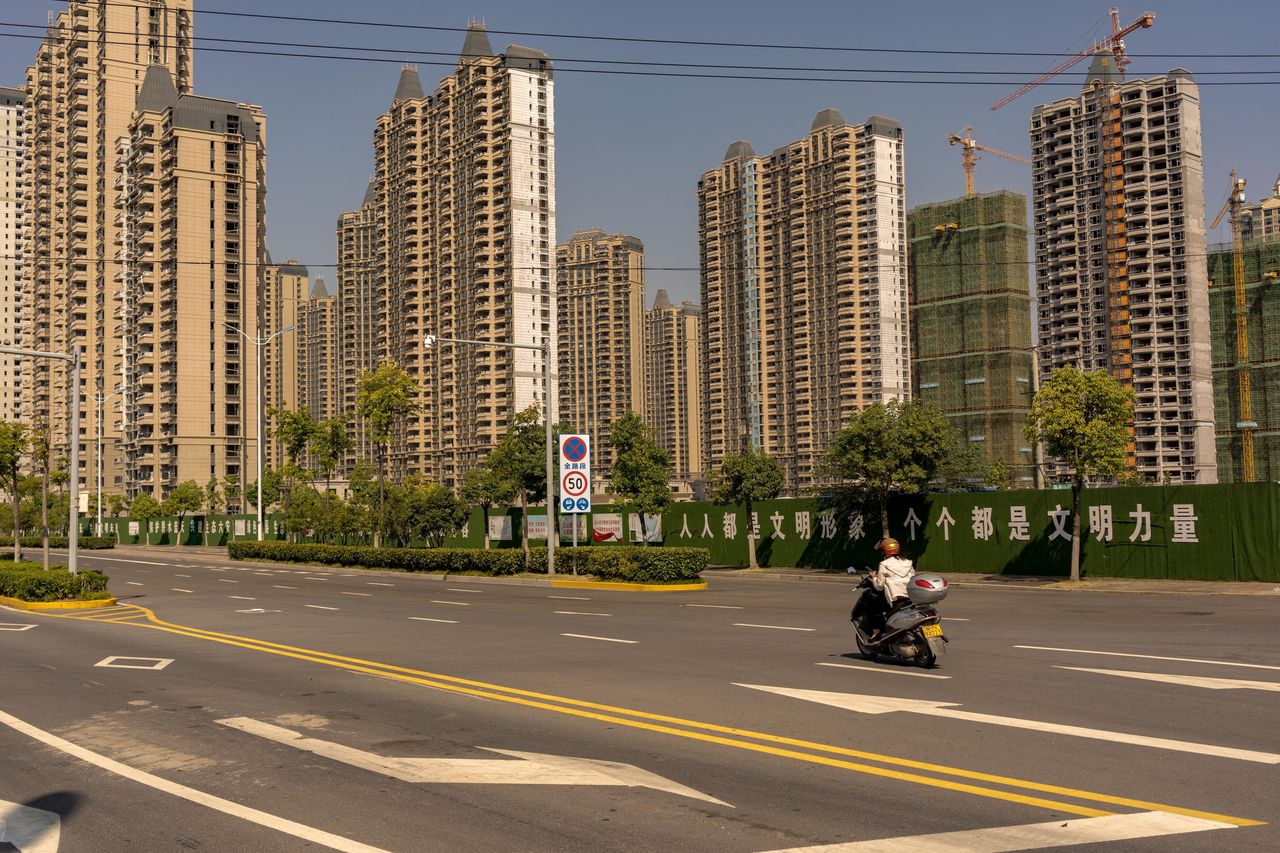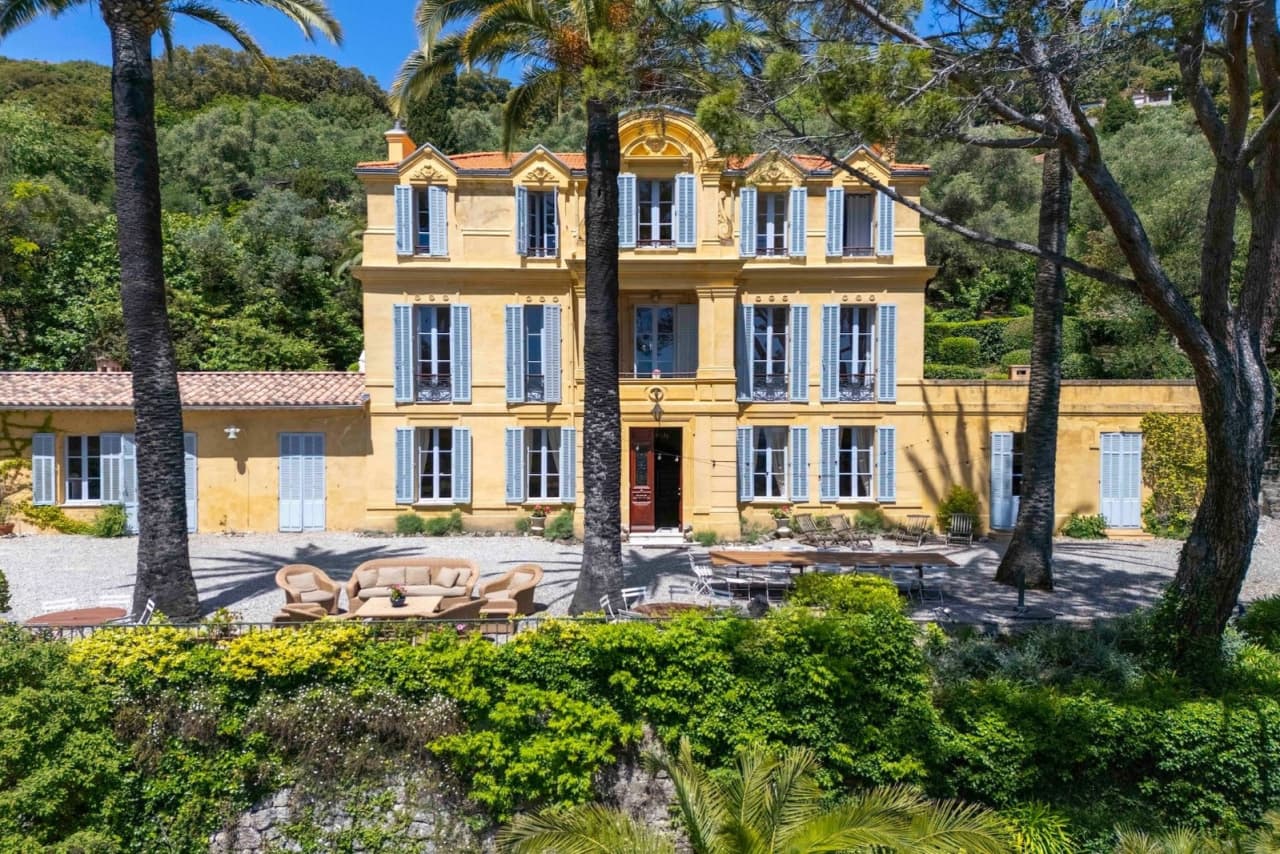Empty Buildings In China’s Provincial Cities Testify To Evergrande Debacle
The property giant borrowed heavily to develop in out-of-the way places like Lu’an.
LU’AN, China—Rows of residential towers, some 26 stories high, stand unfinished in this provincial city about 350 miles west of Shanghai, their plastic tarps flapping in the wind.
Elsewhere in Lu’an, golden Pegasus statues guard an uncompleted $9 billion theme park that was supposed to be bigger than Disneyland. A planned $4 billion electric vehicle plant, central to local leaders’ economic dreams, remains a steel frame with overgrown vegetation spilling into the road.
The structures are monuments to the once-grand ambitions of China Evergrande Group, now among the world’s most indebted property companies, and a case study in how China’s dependence on real estate as an economic engine helped feed those ambitions.
Evergrande is in trouble in part because it developed properties aggressively in places such as Lu’an, where its debt-fueled building spree came as the city’s population dwindled. It launched hundreds of projects across more than 200 Chinese cities.
As it expanded, Evergrande racked up more than US$300 billion in liabilities. In September, it said it was facing unprecedented difficulties and was trying to protect customers. Days later, it missed a scheduled interest payment to overseas bondholders. On Monday, Evergrande and its property-management unit halted trading in Hong Kong; the unit said it could be subject of a takeover bid, which could bring in much-needed cash for Evergrande.
The company’s troubles are among the impacts unfolding since Beijing, concerned about risks to the financial system, last year began forcing developers to start cleaning up their balance sheets. Global investors are worried the crackdown could trigger financial-market distress or a protracted real-estate downturn. People who bought units in unfinished towers are wondering where their money went.
“We spent all our family’s savings on this apartment,” said a 59-year-old farmer surnamed Jiang, who, like other buyers in Lu’an, didn’t want to provide her first name because she is worried about upsetting the company.
In August, she said, she bought a unit for 890,000 yuan (approx. $189,000) in an Evergrande project called Junting, or “Jade Palace,” with 47 apartment buildings. Work halted months ago, locals said. Ms. Jiang said she didn’t know when—or if—it would restart. “We really don’t know what to do,” she said.
Evergrande has completed many projects in Lu’an over the past decade and turned homes over to buyers. An Evergrande spokesman said the company would do everything possible to ensure completion of its projects “wherever the city or region is.” Lu’an officials didn’t respond to requests for comment.
Central to Evergrande’s expansion was a real-estate economy across China in which people from developers to financiers to city leaders had an incentive to perpetuate the boom. Evergrande found a market for its projects among a range of buyers—including corporate employees and farmers seeking to move to more urban areas—who believed values would rise no matter what and assumed Beijing would protect them against decline.
For local leaders, developers represented a revenue stream. With limited power to tax, Chinese cities get roughly a third of their revenue from selling land to property developers like Evergrande. Cities annex farmland to sell to developers; farmers often get to buy apartments at a discount.
Real estate became some cities’ biggest economic driver and the most important source of revenues. Lu’an’s take from land sales totalled US$1.2 billion in the first half of this year, compared with total tax revenue of US$900 million.
But property construction in smaller cities ran well ahead of demand from prospective occupants for the last five years in China, leaving the market increasingly dependent on speculators and investors to buy properties, said Logan Wright, China markets research director at Rhodium Group, a research firm based in New York. About 21% of homes in urban China were already vacant in 2017, which equated to 65 million empty units, according to data from China Household Finance Survey.
As China cracks down, new-home construction has slowed and housing prices are falling in many places. Local governments’ land-sales revenues fell by 17.5% in August from a year ago, according to Rhodium Group.
A sharp deceleration in China’s property market could “exacerbate and amplify downward pressure” on the job market and China’s overall economy, Goldman Sachs economists warned in a recent note. By some estimates, real-estate-related activity now accounts for nearly one-third of China’s economy.
Most economists and investors believe China’s government will restructure Evergrande. Late last month, the People’s Bank of China said it would “maintain the healthy development of the property market and safeguard the legitimate rights and interests of house buyers.”
Still, economists say there will be lost economic activity if Beijing continues to drain away excess debt and root out speculation in real estate.
Some Evergrande projects appear to have fared better in bigger cities. Some Chinese media have reported that while it halted construction on some developments in Guangzhou in southern China, construction on some projects resumed in late September.
Lu’an has lost 5% of its population in the past 10 years. Among Lu’an’s four million people, many are over 60 and residents’ average annual disposable income of $3,500 is below the national average of around $5,000, government data show.
Yet from around 2011 through 2020, Evergrande invested more than $10 billion and launched multiple major projects in Lu’an, including residential complexes, the EV plant and the “Fairyland” theme park featuring pastel-coloured European-style pedestrian blocks and a mélange of animal characters, including a reindeer-like creature and a blue dragon.
Four unfinished Evergrande projects in Lu’an that The Wall Street Journal visited in late September appeared to have stopped construction. Nearby store owners described the loss of business after construction workers stopped showing up. In one Evergrande office, staff took naps or huddled over smartphones.
At least 23 lawsuits involving commercial bills—a form of IOU among Chinese businesses—have been filed this year against Evergrande’s subsidiaries in Anhui province, where Lu’an is located, according to a Journal search on Tianyancha, a corporate database in China. Plaintiffs included makers of paint, cable, concrete and elevators as well as construction companies. The Journal couldn’t find any such lawsuits in the previous year in the database.
‘Dragon-head-like’
Evergrande was founded in 1996 in Guangzhou by Xu Jiayin, who local media says grew up in a poor village as a woodcutter’s son. He became known as Hui Ka Yan, his name in Cantonese.
Mr. Hui expanded Evergrande into a nationwide powerhouse with more than 150,000 workers, reporting record sales year after year as home prices soared. Evergrande’s share price grew more than fivefold in 2017, a year Mr. Hui temporarily became China’s richest man, according to research firm Hurun Report.
The company raised money in part by preselling units to home buyers for cash upfront who then waited for the buildings to rise. Its creditors include buyers of 1.4 million apartments that Evergrande presold and promised to build but hasn’t yet completed, estimates research firm Capital Economics. Evergrande also borrowed from banks and foreign investors.
It expanded beyond real estate, getting into mineral-water production and buying a professional soccer club. It joined the electric-vehicle industry with a Hong Kong-listed EV unit, China Evergrande New Energy Vehicle Group Ltd., whose market capitalization once hit $87 billion, more than most global automakers at the time.
In 2017, it entered the theme-park business, launching 15 projects nationwide involving more than $100 billion in total investment, according to Journal calculations based on local-government numbers. Around that time, Dalian Wanda Group, a conglomerate that had vowed to out-compete Disney parks in China, said it was retreating from the business after running up too much debt.
Principal cities like Beijing and Shanghai kept a tight grip on land supply for new construction, so Evergrande—like many other developers—turned to smaller and more out-of-the-way cities like Lu’an with plenty of land to sell.
When Evergrande began buying land around Lu’an around 2011, it was a sleepy place known mainly for Lu’an Melon Seed Tea. Evergrande launched at least a half-dozen major residential projects in the area while other major developers also rushed in.
Buyers often queued up for hours or went through lotteries to angle for apartments. A senior Anhui province official in 2012 publicly praised Evergrande, local media reported, saying its “strengths in scale and brand name make it a dragon-head-like enterprise in China with international influence.”
Between 2019 and the end of September 2021, Evergrande was Lu’an’s biggest developer based on the number of apartments sold before their construction work was completed, with 8,123 new apartments presold, according to Journal calculations using information from Lu’an’s housing authority.
Evergrande added commercial buildings and a movie theatre. In 2019, it bought 14 more lots in Lu’an, driving the city’s land sales to over $2.6 billion that year, according to Anhui Land Information Network, a research firm tracking government land auctions. The sales helped prompt the local government to increase its fiscal-revenue budget for the year three times.
Evergrande around that time chose Lu’an for one of its EV subsidiary’s plants. Evergrande said it would produce as many as 500,000 cars, generate $15.5 billion in industrial output each year and contribute $1.2 billion in annual tax revenue for the local government, according to local media.
As residential projects rose and residents moved into completed projects, Lu’an transformed into urban sprawl stretching across about 6,000 square miles, with housing-block rows surrounded by farmland. New York City is about 300 square miles.
Cash crunch
Evergrande faced cash crunches over the years but always overcame them. Then Beijing announced plans in August 2020 to crack down on developers’ excessive borrowing via the “three red lines,” limits that kept the company from taking on new debt.
Evergrande’s real estate, theme park and EV subsidiaries each recorded losses during the first half of 2021. Cash became so short the company this summer started paying some suppliers with unfinished apartments, the Journal has reported. In Lu’an, complaints flooded into the local government website, with some buyers of unfinished homes fearing they would lose their life’s savings or be homeless in retirement.
Among the projects whose construction appeared halted last month was a large unfinished portion of Evergrande’s Yujingwan, or “Imperial Scenery Bay,” a complex spanning several blocks. Across the street, a woman giving her name as Ms. Wang, 41, was selling beverages and foodstuffs one recent day at a convenience store she opened in 2017.
Ms. Wang said she bought an apartment last year for more than 400,000 yuan in the complex’s so-called Sixth Phase after Evergrande offered a roughly 35% discount. She borrowed from friends and relatives to buy the new home, which she said is supposed to be ready in 2023.
She said she believes the government, or perhaps a state-owned enterprise, will step in to finish the project. Other buyers echoed that belief.
It isn’t clear where the money that developers like Evergrande collected from home buyers through presales has been going. In many cases, the Journal has reported, developers use that cash as general funding for operations.
The Evergrande theme park was partially operating on the late-September visit, with some small-scale attractions and a handful of restaurants open. Incomplete apartments towered over the park. The carousel was closed.
 Copyright 2020, Dow Jones & Company, Inc. All Rights Reserved Worldwide. LEARN MORE
Copyright 2020, Dow Jones & Company, Inc. All Rights Reserved Worldwide. LEARN MORE
This stylish family home combines a classic palette and finishes with a flexible floorplan
Just 55 minutes from Sydney, make this your creative getaway located in the majestic Hawkesbury region.
Ahead of the Games, a breakdown of the city’s most desirable places to live
PARIS —Paris has long been a byword for luxurious living. The traditional components of the upscale home, from parquet floors to elaborate moldings, have their origins here. Yet settling down in just the right address in this low-rise, high-density city may be the greatest luxury of all.
Tradition reigns supreme in Paris real estate, where certain conditions seem set in stone—the western half of the city, on either side of the Seine, has long been more expensive than the east. But in the fashion world’s capital, parts of the housing market are also subject to shifting fads. In the trendy, hilly northeast, a roving cool factor can send prices in this year’s hip neighborhood rising, while last year’s might seem like a sudden bargain.
This week, with the opening of the Olympic Games and the eyes of the world turned toward Paris, The Wall Street Journal looks at the most expensive and desirable areas in the City of Light.
The Most Expensive Arrondissement: the 6th
Known for historic architecture, elegant apartment houses and bohemian street cred, the 6th Arrondissement is Paris’s answer to Manhattan’s West Village. Like its New York counterpart, the 6th’s starving-artist days are long behind it. But the charm that first wooed notable residents like Gertrude Stein and Jean-Paul Sartre is still largely intact, attracting high-minded tourists and deep-pocketed homeowners who can afford its once-edgy, now serene atmosphere.
Le Breton George V Notaires, a Paris notary with an international clientele, says the 6th consistently holds the title of most expensive arrondissement among Paris’s 20 administrative districts, and 2023 was no exception. Last year, average home prices reached $1,428 a square foot—almost 30% higher than the Paris average of $1,100 a square foot.
According to Meilleurs Agents, the Paris real estate appraisal company, the 6th is also home to three of the city’s five most expensive streets. Rue de Furstemberg, a secluded loop between Boulevard Saint-Germain and the Seine, comes in on top, with average prices of $2,454 a square foot as of March 2024.
For more than two decades, Kyle Branum, a 51-year-old attorney, and Kimberly Branum, a 60-year-old retired CEO, have been regular visitors to Paris, opting for apartment rentals and ultimately an ownership interest in an apartment in the city’s 7th Arrondissement, a sedate Left Bank district known for its discreet atmosphere and plutocratic residents.
“The 7th was the only place we stayed,” says Kimberly, “but we spent most of our time in the 6th.”
In 2022, inspired by the strength of the dollar, the Branums decided to fulfil a longstanding dream of buying in Paris. Working with Paris Property Group, they opted for a 1,465-square-foot, three-bedroom in a building dating to the 17th century on a side street in the 6th Arrondissement. They paid $2.7 million for the unit and then spent just over $1 million on the renovation, working with Franco-American visual artist Monte Laster, who also does interiors.
The couple, who live in Santa Barbara, Calif., plan to spend about three months a year in Paris, hosting children and grandchildren, and cooking after forays to local food markets. Their new kitchen, which includes a French stove from luxury appliance brand Lacanche, is Kimberly’s favourite room, she says.
Another American, investor Ashley Maddox, 49, is also considering relocating.
In 2012, the longtime Paris resident bought a dingy, overstuffed 1,765-square-foot apartment in the 6th and started from scratch. She paid $2.5 million and undertook a gut renovation and building improvements for about $800,000. A centrepiece of the home now is the one-time salon, which was turned into an open-plan kitchen and dining area where Maddox and her three children tend to hang out, American-style. Just outside her door are some of the city’s best-known bakeries and cheesemongers, and she is a short walk from the Jardin du Luxembourg, the Left Bank’s premier green space.
“A lot of the majesty of the city is accessible from here,” she says. “It’s so central, it’s bananas.” Now that two of her children are going away to school, she has listed the four-bedroom apartment with Varenne for $5 million.
The Most Expensive Neighbourhoods: Notre-Dame and Invalides
Garrow Kedigian is moving up in the world of Parisian real estate by heading south of the Seine.
During the pandemic, the Canada-born, New York-based interior designer reassessed his life, he says, and decided “I’m not going to wait any longer to have a pied-à-terre in Paris.”
He originally selected a 1,130-square-foot one-bedroom in the trendy 9th Arrondissement, an up-and-coming Right Bank district just below Montmartre. But he soon realised it was too small for his extended stays, not to mention hosting guests from out of town.
After paying about $1.6 million in 2022 and then investing about $55,000 in new decor, he put the unit up for sale in early 2024 and went house-shopping a second time. He ended up in the Invalides quarter of the 7th Arrondissement in the shadow of one Paris’s signature monuments, the golden-domed Hôtel des Invalides, which dates to the 17th century and is fronted by a grand esplanade.
His new neighbourhood vies for Paris’s most expensive with the Notre-Dame quarter in the 4th Arrondissement, centred on a few islands in the Seine behind its namesake cathedral. According to Le Breton, home prices in the Notre-Dame neighbourhood were $1,818 a square foot in 2023, followed by $1,568 a square foot in Invalides.
After breaking even on his Right Bank one-bedroom, Kedigian paid $2.4 million for his new 1,450-square-foot two-bedroom in a late 19th-century building. It has southern exposures, rounded living-room windows and “gorgeous floors,” he says. Kedigian, who bought the new flat through Junot Fine Properties/Knight Frank, plans to spend up to $435,000 on a renovation that will involve restoring the original 12-foot ceiling height in many of the rooms, as well as rescuing the ceilings’ elaborate stucco detailing. He expects to finish in 2025.
Over in the Notre-Dame neighbourhood, Belles demeures de France/Christie’s recently sold a 2,370-square-foot, four-bedroom home for close to the asking price of about $8.6 million, or about $3,630 a square foot. Listing agent Marie-Hélène Lundgreen says this places the unit near the very top of Paris luxury real estate, where prime homes typically sell between $2,530 and $4,040 a square foot.
The Most Expensive Suburb: Neuilly-sur-Seine
The Boulevard Périphérique, the 22-mile ring road that surrounds Paris and its 20 arrondissements, was once a line in the sand for Parisians, who regarded the French capital’s numerous suburbs as something to drive through on their way to and from vacation. The past few decades have seen waves of gentrification beyond the city’s borders, upgrading humble or industrial districts to the north and east into prime residential areas. And it has turned Neuilly-sur-Seine, just northwest of the city, into a luxury compound of first resort.
In 2023, Neuilly’s average home price of $1,092 a square foot made the leafy, stately community Paris’s most expensive suburb.
Longtime residents, Alain and Michèle Bigio, decided this year is the right time to list their 7,730-square-foot, four-bedroom townhouse on a gated Neuilly street.
The couple, now in their mid 70s, completed the home in 1990, two years after they purchased a small parcel of garden from the owners next door for an undisclosed amount. Having relocated from a white-marble château outside Paris, the couple echoed their previous home by using white- and cream-coloured stone in the new four-story build. The Bigios, who will relocate just back over the border in the 16th Arrondissement, have listed the property with Emile Garcin Propriétés for $14.7 million.
The couple raised two adult children here and undertook upgrades in their empty-nester years—most recently, an indoor pool in the basement and a new elevator.
The cool, pale interiors give way to dark and sardonic images in the former staff’s quarters in the basement where Alain works on his hobby—surreal and satirical paintings, whose risqué content means that his wife prefers they stay downstairs. “I’m not a painter,” he says. “But I paint.”
The Trendiest Arrondissement: the 9th
French interior designer Julie Hamon is theatre royalty. Her grandfather was playwright Jean Anouilh, a giant of 20th-century French literature, and her sister is actress Gwendoline Hamon. The 52-year-old, who divides her time between Paris and the U.K., still remembers when the city’s 9th Arrondissement, where she and her husband bought their 1,885-square-foot duplex in 2017, was a place to have fun rather than put down roots. Now, the 9th is the place to do both.
The 9th, a largely 19th-century district, is Paris at its most urban. But what it lacks in parks and other green spaces, it makes up with nightlife and a bustling street life. Among Paris’s gentrifying districts, which have been transformed since 2000 from near-slums to the brink of luxury, the 9th has emerged as the clear winner. According to Le Breton, average 2023 home prices here were $1,062 a square foot, while its nearest competitors for the cool crown, the 10th and the 11th, have yet to break $1,011 a square foot.
A co-principal in the Bobo Design Studio, Hamon—whose gut renovation includes a dramatic skylight, a home cinema and air conditioning—still seems surprised at how far her arrondissement has come. “The 9th used to be well known for all the theatres, nightclubs and strip clubs,” she says. “But it was never a place where you wanted to live—now it’s the place to be.”
With their youngest child about to go to college, she and her husband, 52-year-old entrepreneur Guillaume Clignet, decided to list their Paris home for $3.45 million and live in London full-time. Propriétés Parisiennes/Sotheby’s is handling the listing, which has just gone into contract after about six months on the market.
The 9th’s music venues were a draw for 44-year-old American musician and piano dealer, Ronen Segev, who divides his time between Miami and a 1,725-square-foot, two-bedroom in the lower reaches of the arrondissement. Aided by Paris Property Group, Segev purchased the apartment at auction during the pandemic, sight unseen, for $1.69 million. He spent $270,000 on a renovation, knocking down a wall to make a larger salon suitable for home concerts.
During the Olympics, Segev is renting out the space for about $22,850 a week to attendees of the Games. Otherwise, he prefers longer-term sublets to visiting musicians for $32,700 a month.
Most Exclusive Address: Avenue Junot
Hidden in the hilly expanses of the 18th Arrondissement lies a legendary street that, for those in the know, is the city’s most exclusive address. Avenue Junot, a bucolic tree-lined lane, is a fairy-tale version of the city, separate from the gritty bustle that surrounds it.
Homes here rarely come up for sale, and, when they do, they tend to be off-market, or sold before they can be listed. Martine Kuperfis—whose Paris-based Junot Group real-estate company is named for the street—says the most expensive units here are penthouses with views over the whole of the city.
In 2021, her agency sold a 3,230-square-foot triplex apartment, with a 1,400-square-foot terrace, for $8.5 million. At about $2,630 a square foot, that is three times the current average price in the whole of the 18th.
Among its current Junot listings is a 1930s 1,220-square-foot townhouse on the avenue’s cobblestone extension, with an asking price of $2.8 million.
This stylish family home combines a classic palette and finishes with a flexible floorplan
Just 55 minutes from Sydney, make this your creative getaway located in the majestic Hawkesbury region.






















